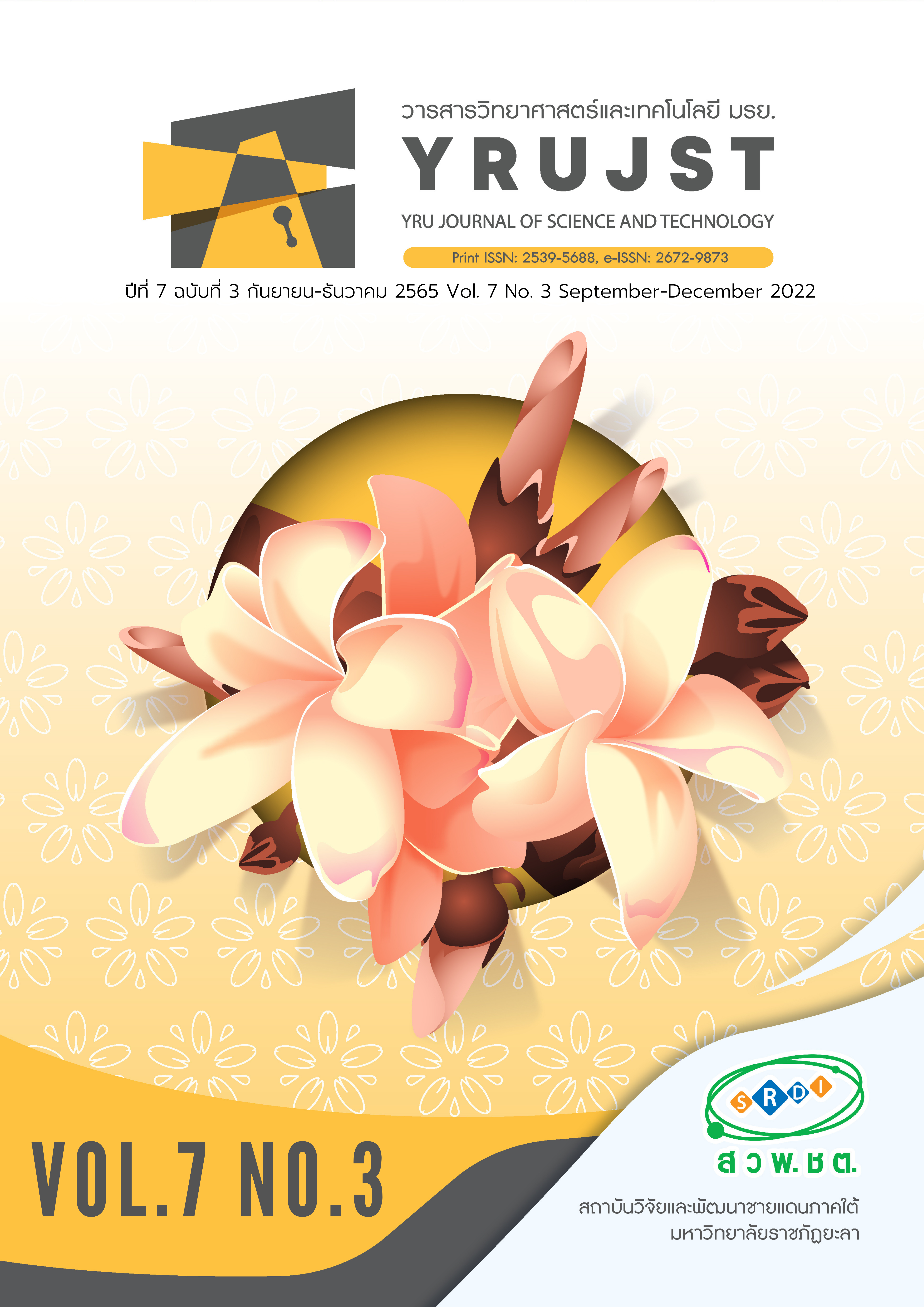Kinetic and Isotherms Studies of Hexavalent Chromium Adsorption by Mimosa pigra L. Adsorbents
Main Article Content
Abstract
Hexavalent chromium is a dangerous substance to living things and can contaminate into soi and water. Disposal this substance is very important and can be done in several ways. Adsorption by using adsorbent made from weed is another way which getting a lot of attention nowadays. This study is aimed to produce adsorbent from modified Mimosa pigra L. and activated carbon from Mimosa pigra L. using ZnCl2 as an activated agent. BET isotherm of nitrogen adsorption was conducted to identify the surface area value of the adsorbents. Scanning electron microscope was used to analyze the surface morphology of the adsorbents. The results showed that the surface area of modified Mimosa pigra L. and activated carbon from Mimosa pigra L. are 406.20 and 796.75 m2/g, respectively. The batch adsorption method was used to study kinetic and isotherm adsorption of hexavalent chromium. The flame atomic absorption spectrophotometer was used to analyze the concentration of hexavalent chromium solution after adsorption. The result indicated that the kinetic model of the adsorption process of both adsorbents was found to follow a pseudo second order model. The adsorption quantity will enter into an equilibrium state after 60 minutes. The maximum adsorption value is 77.52 mg/g for the activated carbon from Mimosa pigra L. which correspond to its surface area and average pore size value. Therefore, the adsorption behavior of both adsorbents is fitted with the Langmuir isotherm model. The preparation of both absorbents can increase the adsorption efficiency and is another alternative way to treat wastewater and to utilize the Mimosa pigra L. to its benefits.
Article Details

This work is licensed under a Creative Commons Attribution-NonCommercial-NoDerivatives 4.0 International License.
บทความ ข้อมูล เนื้อหา รูปภาพ ฯลฯ ที่ได้รับการเผยแพร่ในวารสารวิทยาศาสตร์และเทคโนโลยี มรย. นี้ ถือเป็นลิขสิทธิ์ของวารสารวิทยาศาสตร์และเทคโนโลยี มรย. หากบุคคลหรือหน่วยงานใดต้องการนำทั้งหมดหรือส่วนหนึ่งส่วนใดไปเผยแพร่ต่อหรือกระทำการใดๆ จะต้องได้รับอนุญาตเป็นลายลักษณ์อักษรจากวารสารวิทยาศาสตร์และเทคโนโลยี มรย. ก่อนเท่านั้น
References
Koodkaew, I., Senaphan, C., Sengseang, N. & Suwanwong, S. (2018). Characterization of phytochemical profile and phytotoxic activity of Mimosa pigra L. Agriculture and Natural Resources, 52(2), 162-168.
Krishnamoorthi, K., Shanmugam, A. & Murugan, A. (2021). Adsorption of hexavalent chromium by activated carbon Merremia Emarginata (ACME) from synthetic aqueous solutions. Journal of Advanced Scientific Research, 12(2), 159-164.
Mahaninia, M., Rahimian, P. & Kaghazchi, T., (2015). Modified activated carbons with amino groups and their copper adsorption properties in aqueous solution. Chinese Journal of Chemical Engineering, 23(1), 50-56.
Masinga, T., Moyo, M. & Pakade, V.E. (2022). Removal of hexavalent chromium by polyethyleneimine impregnated activated carbon: intra-particle diffusion, kinetics and isotherms. Journal of materials research and technology, 18, 1333-1344.
Morifi, E., Chimuka, L., Richards, H., Senyolo, L. & Pillay, K. (2022). Modified macadamia nutshell nanocomposite for selective removal of hexavalent chromium from wastewater. South African Journal of Chemical Engineering, 42, 176-187.
Ninjiaranai, P. & Noirod, P. (2016) Adsorption efficiency of chromium (VI) on cottonseed fruit and giant mimosa. Huachiew Chalermprakiet Science and Technology Journal, 2(2), 28-36. (in Thai)
Okonkwo, C. J., Tochukwu, U. N., Okonkwo, J. N., Afieroho, O. E. & Proksch, P. (2016). Two new acylated flavonol glycosides from Mimosa pigra L. leaves sub-family Mimosoideae. Future Journal of Pharmaceutical Sciences, 2(2), 71-75.
Onsaikaew, K. & Panya, P. (2021). Electrochemical resistance of activated carbons from preparation with cucurbit peel activated by different activators. VRU Research and Development Journal Science and Technology, 16(3), 105-119. (in Thai)
Pakade, V.E., Nchoe, O.B., Hlungwane, L. & Tavengwa, N.T. (2017). Sequestration of hexavalent chromium from aqueous solutions by activated carbon derived from Macadamia nutshells. Water Sci Technol, 75, 196-206.
Pant, B. D., Neupane, D., Paudel, D. R., Lohani, P. C., Gautam, S. K., Pokhrel, M. R. & Poudel, B.R. (2022). Efficient biosorption of hexavalent chromium from water by modified arecanut leaf sheath. Heliyon, 8(4), e09283 1-10.
Panya, P. (2014). Surface Chemistry (1st ed.). Kamphaeng Phet: Kamphaeng Phet Rajabhat University. (in Thai)
Rajoriya, S., Saharan, V. K., Pundir, A. S., Nigam, M. & Roy, K. (2021). Adsorption of methyl red dye from aqueous solution onto eggshell waste material: kinetics, isotherms and thermodynamic studies. Current Research in Green and Sustainable Chemistry, 4, 100180, 1-7.
Singhasiri, T. (2014). Optimum conditions of activated carbon production from MIMOSA PIGRA L. using sodium chloride and zing chloride activation. KKU Engineering Journal, 41(4), 527-535. (in Thai)
Sinha, R., Kumar, R., Sharma, P., Kant, N., Shang, J. & Aminabhavi, T. M. (2022). Removal of hexavalent chromium via biochar-based adsorbents: state-of-the-art, challenges, and future perspectives. Journal of Environmental Management, 317, 115356, 1-33.
Suanjaidee, T. & Panya, P. (2016). Removal of phenol by adsorption on modified activated carbon with cetylpyridinium chloride. The Golden Teak Science and Technology Journal 3(2), 69-76. (in Thai)
Thammasom, T. (2017). Study adsorption of cadmium by activated carbon from Mimosa Pigra Linn. Science and Technology RMUTT Journal, 7, 59-66. (in Thai)
Uner, O., Gecgel, U. & Bayrak, Y. (2019). Preparation and characterization of mesoporous activated carbons from waste watermelon rind by using the chemical activation method with zinc chloride. Arabian Journal of Chemistry, 12, 3621–3627.
Yahya, A.Y., Al-Qodah, Z. & Zanariah Ngah, C.W. (2015). Agricultural bio-mass materials as potential stainable precursors used for activated carbon production: a review. Renewable and Sustainable Energy Reviews, 46, 218–235.


